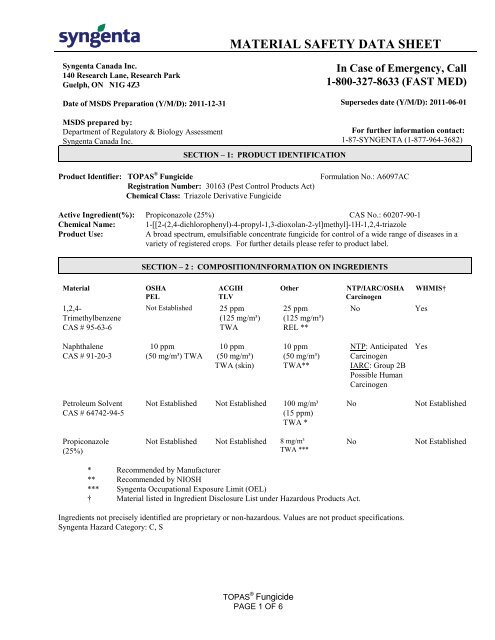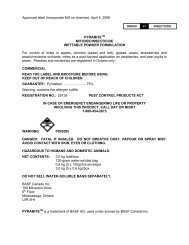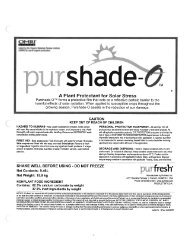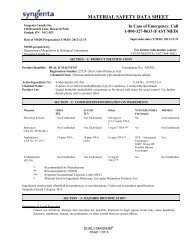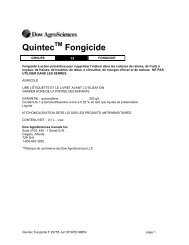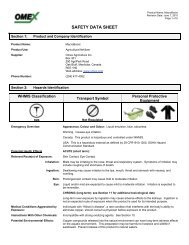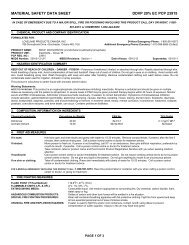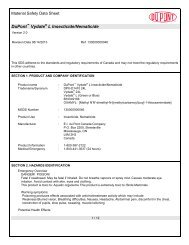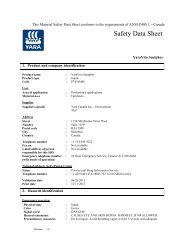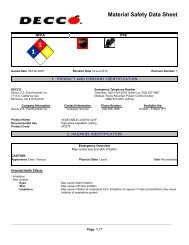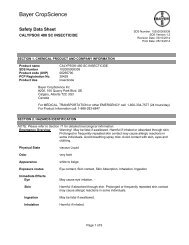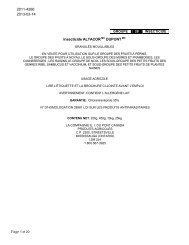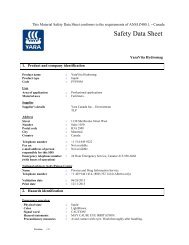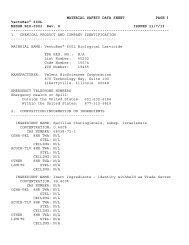Topas 250EC msds english.pdf - Bartlett.ca
Topas 250EC msds english.pdf - Bartlett.ca
Topas 250EC msds english.pdf - Bartlett.ca
- No tags were found...
Create successful ePaper yourself
Turn your PDF publications into a flip-book with our unique Google optimized e-Paper software.
MATERIAL SAFETY DATA SHEETSyngenta Canada Inc.140 Research Lane, Research ParkGuelph, ON N1G 4Z3Date of MSDS Preparation (Y/M/D): 2011-12-31In Case of Emergency, Call1-800-327-8633 (FAST MED)Supersedes date (Y/M/D): 2011-06-01MSDS prepared by:Department of Regulatory & Biology AssessmentSyngenta Canada Inc.SECTION – 1: PRODUCT IDENTIFICATIONFor further information contact:1-87-SYNGENTA (1-877-964-3682)Product Identifier: TOPAS ® FungicideRegistration Number: 30163 (Pest Control Products Act)Chemi<strong>ca</strong>l Class: Triazole Derivative FungicideFormulation No.: A6097ACActive Ingredient(%): Propiconazole (25%) CAS No.: 60207-90-1Chemi<strong>ca</strong>l Name: 1-[[2-(2,4-dichlorophenyl)-4-propyl-1,3-dioxolan-2-yl]methyl]-1H-1,2,4-triazoleProduct Use:A broad spectrum, emulsifiable concentrate fungicide for control of a wide range of diseases in avariety of registered crops. For further details please refer to product label.SECTION – 2 : COMPOSITION/INFORMATION ON INGREDIENTSMaterial1,2,4-TrimethylbenzeneCAS # 95-63-6OSHAPELNot EstablishedACGIHTLV25 ppm(125 mg/m³)TWAOther25 ppm(125 mg/m³)REL **NTP/IARC/OSHACarcinogenNoWHMIS†YesNaphthaleneCAS # 91-20-310 ppm(50 mg/m³) TWA10 ppm(50 mg/m³)TWA (skin)10 ppm(50 mg/m³)TWA**NTP: AnticipatedCarcinogenIARC: Group 2BPossible HumanCarcinogenYesPetroleum SolventCAS # 64742-94-5Not Established Not Established 100 mg/m³(15 ppm)TWA *NoNot EstablishedPropiconazole(25%)Not Established Not Established 8 mg/m³TWA ***NoNot Established* Recommended by Manufacturer** Recommended by NIOSH*** Syngenta Occupational Exposure Limit (OEL)† Material listed in Ingredient Disclosure List under Hazardous Products Act.Ingredients not precisely identified are proprietary or non-hazardous. Values are not product specifi<strong>ca</strong>tions.Syngenta Hazard Category: C, STOPAS ® FungicidePAGE 1 OF 6
SECTION – 3: HAZARDS IDENTIFICATIONSymptoms of Acute ExposureHarmful if inhaled. May <strong>ca</strong>use eye, skin and respiratory irritation. Exposure to high vapour levels may <strong>ca</strong>useheadache, dizziness, numbness, nausea, incoordination, or other central nervous system effects.Hazardous Decomposition ProductsHydrogen cyanide.Physi<strong>ca</strong>l PropertiesAppearance: Clear yellow liquid.Odour: Aromatic solvent.Unusual Fire, Explosion and Reactivity HazardsCombustible liquid. Can release vapours that form explosive mixtures at temperatures at or above the flash point.Heavy vapours <strong>ca</strong>n flow along surfaces to distant ignition sources and flash back.During a fire, irritating and possibly toxic gases may be generated by thermal decomposition or combustion.Potential Health EffectsRelevant routes of exposure: Skin, eyes, mouth, lungs.SECTION – 4: FIRST AID MEASURESIF POISONING IS SUSPECTED, immediately contact the poison information centre, doctor or nearest hospital. Havethe product container, label or Material Safety Data Sheet with you when <strong>ca</strong>lling Syngenta, a poison control center ordoctor, or going for treatment. Tell the person contacted the complete product name, and the type and amount of exposure.Describe any symptoms and follow the advice given. Call the Syngenta Emergency Line [1-800-327-8633 (1-800-FASTMED)], for further information.EYE CONTACT:SKIN CONTACT:INHALATION:INGESTION:Flush eyes with clean water, holding eyelids apart for a minimum of 15-20 minutes. Removecontact lenses, if present, after 5 minutes, then continue rinsing eye. Call Syngenta, a poisoncontrol center or doctor for treatment advice. Obtain medi<strong>ca</strong>l attention immediately if irritationpersists.Immediately remove contaminated clothing and wash skin, hair and fingernails thoroughly withsoap and water. Flush skin with plenty of water for 15-20 minutes. Call Syngenta, a poison controlcentre or doctor for treatment advice.Move victim to fresh air. If not breathing, <strong>ca</strong>ll 911 or an ambulance, then give artificialrespiration, preferably mouth-to-mouth, if possible. Call Syngenta, a poison control centre ordoctor for treatment advice.If swallowed, immediately contact Syngenta, a poison control centre, doctor or nearest hospital fortreatment advice. Do not induce vomiting unless directed by a physician or a poison controlcenter. Do not give any liquid to the person. Call Syngenta, a poison control centre or doctor fortreatment advice.NOTES TO PHYSICIAN:There is no specific antidote if this product is ingested. Treat symptomati<strong>ca</strong>lly. Contains petroleum distillate -vomiting may <strong>ca</strong>use aspiration pneumonia.Induction of emesis is not recommended due to the large amount of petroleum solvent in this product, which could<strong>ca</strong>use chemi<strong>ca</strong>l pneumonitis if aspirated.MEDICAL CONDITIONS KNOWN TO BE AGGRAVATED:Persons with preexisting dermatitis, respiratory disorders, or an allergic history should use extra <strong>ca</strong>re in handlingthis product.TOPAS ® FungicidePAGE 2 OF 6
SECTION – 5: FIRE FIGHTING MEASURESFlash point and method: 62 ºC (P.M.C.C.).Upper and lower flammable (explosive) limits in air: Lower: 1.8% Upper: 11.7%Auto-ignition temperature: Not Available.Flammability: Combustible liquid.Hazardous combustion products: Toxic, flammable fumes are released by thermal decomposition in a fire. Thermaldecomposition products may include hydrogen cyanide.Conditions under which flammability could occur: Can release vapours that form explosive mixtures at temperatures at orabove the flash point. Heavy vapours <strong>ca</strong>n flow along surfaces to distant ignition sources and flash back. Keep fire exposedcontainers cool by spraying with water.Extinguishing media: Use foam, <strong>ca</strong>rbon dioxide, dry powder, halon extinguishant or water fog or mist, (avoid use of waterjet). Wear full protective clothing and self-contained breathing apparatus. Evacuate nonessential personnel from the area toprevent human exposure to fire, smoke, fumes or products of combustion. Prevent use of contaminated buildings, area, andequipment until decontaminated. Water runoff <strong>ca</strong>n <strong>ca</strong>use environmental damage. Contain run-off water with, for example,temporary earth barriers.Sensitivity to explosion by mechani<strong>ca</strong>l impact: No.Sensitivity to explosion by static discharge: Yes.SECTION – 6: ACCIDENTAL RELEASE MEASURESPersonal Pre<strong>ca</strong>utions: Make sure all personnel involved in the spill cleanup follow good industrial hygiene practices. Asmall spill <strong>ca</strong>n be handled routinely. Use adequate ventilation and wear equipment and clothing as described in Section 8and/or the product label.Procedures for dealing with release or spill: Control the spill at its source. Contain the spill to prevent from spreading orcontaminating soil or from entering sewage and drainage systems or any body of water. Clean up spills immediately,observing pre<strong>ca</strong>utions outlined in Sections 7 and 8. Pump or scoop large amounts of liquid into a disposable container.Absorb remaining liquid or smaller spills with clay, sand or vermiculite. Scoop or sweep up material and place into adisposal container. On soils, small amounts will naturally decompose. For large amounts, skim off the upper contaminatedlayer and collect for disposal. Once all material is cleaned up and placed in a disposal container, seal container and arrangefor disposal. Spillages or uncontrolled discharges into watercourses must be reported to the appropriate regulatoryauthority.SECTION – 7: HANDLING AND STORAGEHandling practices: KEEP OUT OF REACH OF CHILDREN. Prevent eating, drinking, tobacco use, and cosmeti<strong>ca</strong>ppli<strong>ca</strong>tion in areas where there is a potential for exposure to the material. Avoid breathing vapours or spray mist. Wear fullprotective clothing and equipment (see Section 8). After work, rinse gloves and remove protective equipment, and washhands thoroughly with soap and water after handling, and before eating, tobacco use, drinking, applying cosmetics or usingthe toilet. Wash contaminated clothing before re-use and separate from household laundry. Keep containers closed whennot in use. Protect product, wash or rinse water, and contaminated materials from uncontrolled release into theenvironment, or from access by animals, birds or unauthorized people.Appropriate storage practices/requirements: Store in original container only in a well-ventilated, cool, dry, secure area.Protect from heat, sparks and flame. Do not expose containers to temperatures above 40 °C. Keep separate from otherproducts to prevent cross contamination. Rotate stock. Clean up spilled material immediately.National Fire Code classifi<strong>ca</strong>tion: Class IIIA Combustible Liquid.SECTION – 8: EXPOSURE CONTROLS/PERSONAL PROTECTIONAppli<strong>ca</strong>ble control measures, including engineering controls: This product is intended for use outdoors where engineeringcontrols are not necessary. If necessary, ensure work areas have ventilation, containment, and procedures sufficient to maintainairborne levels below the TLV. Warehouses, production area, parking lots and waste holding facilities must have adequatecontainment to prevent environmental contamination. Provide separate shower and eating facilities.TOPAS ® FungicidePAGE 3 OF 6
THE FOLLOWING RECOMMENDATIONS FOR EXPOSURE CONTROLS/PERSONAL PROTECTION ARE INTENDEDFOR THE MANUFACTURE, FORMULATION, PACKAGING AND USE OF THIS PRODUCT.CONSULT THE PRODUCT LABEL FOR COMMERCIAL APPLICATIONS AND/OR ON-FARM APPLICATIONS.Personal protective equipment for each exposure route:General: Avoid breathing dust, vapours or aerosols. Avoid contact with eye, skin and clothing. Wash thoroughly afterhandling and before eating, drinking, applying cosmetics or handling tobacco.INGESTION: Do not eat, drink, handle tobacco, or apply cosmetics in areas where there is a potential for exposure tothis material. Always wash thoroughly after handling.EYES: Where eye contact is likely, use chemi<strong>ca</strong>l splash goggles. Facilities storing or utilizing this materialSKIN:should be equipped with an eyewash facility and a safety shower.Where contact is likely, wear chemi<strong>ca</strong>l-resistant (such as nitrile or butyl) gloves, coveralls, socks andchemi<strong>ca</strong>l-resistant footwear. For overhead exposure, wear chemi<strong>ca</strong>l-resistant headgear.INHALATION: A respirator is not normally required when handling this substance. A combination particulate/organicvapour respirator should be used until effective engineering controls are installed to comply withoccupational exposure limits, or until exposure limits are established. Use a NIOSH approved respiratorwith an organic vapour (OV) <strong>ca</strong>rtridge or <strong>ca</strong>nister with any R, P or HE filter.Use a self-contained breathing apparatus in <strong>ca</strong>ses of emergency spills, when exposure levels areunknown, or under any circumstances where air-purifying respirators may not provide adequateprotection.SECTION – 9: PHYSICAL AND CHEMICAL PROPERTIESAppearance: Clear yellow liquid.Formulation Type: Emulsifiable concentrate.Odour: Aromatic solvent odour.pH: 5.4 – 8.0 (1% emulsion in water @ 25 °C.).Vapour pressure and reference temperature: 4.2 x 10 -7 mmHg @ 25 °C (Propiconazole Techni<strong>ca</strong>l).Vapour density: Not available.Boiling point: Not available.Melting point: Not available.Freezing point: -40 °C.Specific gravity or density: 0.98 g/cm 3 @ 20 °C.Evaporation Rate: Not available.Water/oil partition coefficient: Log P = 3.65 (Propiconazole Techni<strong>ca</strong>l).Odour threshold: Not available.Viscosity: 5.1 cps (or mPas) @ 21 °C.Solubility in Water: 0.1 g/L @ 20 ºC (Propiconazole Techni<strong>ca</strong>l).SECTION – 10: STABILITY AND REACTIVITYChemi<strong>ca</strong>l stability: Stable under normal use and storage conditions.Conditions to avoid: Keep away from heat or open flames.Incompatibility with other materials: Nitric acid, sulfuric acid, strong oxidizing and reducing agents.Hazardous decomposition products: Hydrogen cyanide.Hazardous polymerization: Will not occur.SECTION – 11: TOXICOLOGICAL INFORMATIONAcute toxicity/Irritation Studies (Finished Product) :Ingestion:Low Acute ToxicityOral (LD50 Rat):2,105 mg/kg body weightDermal:Low Acute ToxicityDermal (LD50 Rabbit):4,250 mg/kg body weightTOPAS ® FungicidePAGE 4 OF 6
Inhalation:Eye Contact:Skin Contact:Slightly Acutely ToxicInhalation (LC50 Rat):Moderately Irritating (Rabbit)Moderately Irritating (Rabbit)> 1.0 mg/L air - 4 hoursSkin Sensitization:Reproductive/Developmental EffectsPropiconazole Techni<strong>ca</strong>l:Chronic/Subchronic Toxicity StudiesPropiconazole Techni<strong>ca</strong>l:CarcinogenicityPropiconazole Techni<strong>ca</strong>l:Potential Skin Sensitizer (Guinea Pig) (Based on the techni<strong>ca</strong>l)None observed.None observed.Long-term exposure of mice to high dose levels of propiconazole produced anincrease in liver tumors in male mice. Propiconazole is not considered to be<strong>ca</strong>rcinogenic.Other Toxicity Information:None.Toxicity of Other ComponentsThe acute toxicity test results reported in Section 11, above, for the finished product take into account any acutehazards related to the “other components” in the formulation.1,2,4-TrimethylbenzeneInhalation of 1,2,4-trimethylbenzene at high concentrations <strong>ca</strong>n <strong>ca</strong>use central nervous system depression,respiratory tract irritation, asphyxiation, <strong>ca</strong>rdiac stress and coma. Effects of chronic exposure to thissolvent <strong>ca</strong>n include blood disorders (anemia, leukopenia) and kidney or liver damage.NaphthaleneExposure to naphthalene <strong>ca</strong>n <strong>ca</strong>use <strong>ca</strong>taracts, liver damage, kidney failure, respiratory failure, hematuria,anemia, damage to red blood cells, leukocytosis, or coma.Carcinogen Status:NTP: Anticipated CarcinogenIARC: Group 2B Possible Human CarcinogenPetroleum SolventInhalation of vapours at high concentrations <strong>ca</strong>n <strong>ca</strong>use central nervous system effects (dizziness,headache), irritation to eyes or respiratory tract.Target OrgansActive IngredientsPropiconazole Techni<strong>ca</strong>l:Inert Ingredients1,2,4-Trimethylbenzene:Naphthalene:Petroleum Solvent:Liver, skin, eye.CNS, liver, kidney, blood, respiratory tract, skin, eyeEye, liver, kidney, respiratory tract, blood, CNSRespiratory tract, stomach, liver, thyroid, urinary bladder, CNS,skinSECTION – 12: ECOLOGICAL INFORMATIONSummary of EffectsThe active ingredient, propiconazole, is practi<strong>ca</strong>lly nontoxic to plants birds and insects, but is very toxic to aquaticlife.TOPAS ® FungicidePAGE 5 OF 6
Eco-Acute ToxicityPropiconazole Techni<strong>ca</strong>l:Green Algae 5-Day EC 501.6 ppmInvertebrates (Daphnia magna) 48-hour LC 50 /EC 50 4.8 ppmFish (Rainbow Trout) 96-hour LC 50 /EC 500.85 ppmBird (Mallard Duck) 14-Day LC 502,510 mg/kgEnvironmental FateThe active ingredient, propiconazole, has a low bioaccumulation potential, low mobility, and low to moderatepersistence in soil and water. The Dissipation half-life in soil is 70 days. The main route of degradation is by microbialdegradation and formation of bound residues.SECTION – 13: DISPOSAL CONSIDERATIONSWaste disposal information: Do not reuse empty containers unless they are specifi<strong>ca</strong>lly designed to be re-filled. Emptycontainer retains product residue. Dispose of empty containers in accordance with lo<strong>ca</strong>l regulations. Consult provincialenvironment ministry for advice on waste disposal. Industrial/commercial waste may be handled at licensed facilities only.Waste shipments must be securely packaged and properly labelled. Only licensed <strong>ca</strong>rriers may be used, and proper documentsmust accompany the shipment.SECTION – 14 : TRANSPORT INFORMATIONShipping information such as shipping classifi<strong>ca</strong>tion:TRANSPORTATION OF DANGEROUS GOODS CLASSIFICATION - ROAD/RAILNot Regulated.SECTION – 15: REGULATORY INFORMATIONWHMIS classifi<strong>ca</strong>tion for product: ExemptA statement that the MSDS has been prepared to meet WHMIS requirements, except for use of the 16 headings.This MSDS has been prepared in accordance with WHMIS requirements, but the data are presented under 16 headings.Other regulations; restrictions and prohibitionsPest Control Products (PCP) Act Registration No.: 30163SECTION – 16: OTHER INFORMATIONThe information contained herein is offered only as a guide to the handling of this specific material and has been preparedin good faith by techni<strong>ca</strong>lly knowledgeable personnel. It is not intended to be all-inclusive and the manner and conditionsof use and handling may involve other and additional considerations. No warranty of any kind is given or implied andSyngenta will not be liable for any damages, losses, injuries or consequential damages which may result from the use of orreliance on any information contained herein. This Material Safety Data Sheet is valid for three years. This product is underthe jurisdiction of the Pest Control Products Act and is exempt from the requirements for a WHMIS compliant MSDS.Hazardous properties of all ingredients have been considered in the preparation of this MSDS. Read the entire MSDS forthe complete hazard evaluation of this product.Prepared by: Syngenta Canada Inc.1-87-SYNGENTA (1-877-964-3682)Syngenta Canada Inc. believes that the information and recommendations contained herein (including data and statements)are accurate as of the date thereof. NO WARRANTY OF FITNESS FOR ANY PARTICULAR PURPOSE, WARRANTYOF MERCHANTABILITY, OR ANY OTHER WARRANTY, EXPRESS OR IMPLIED, IS MADE CONCERNING THEINFORMATION PROVIDED HEREIN. The information provided herein relates to the specific product designated andmay not be valid where such product is used in combination with any other materials or in any process. Further, since theconditions and methods of use of the product and of the information referred to herein are beyond the control of SyngentaCanada Inc., Syngenta Canada Inc. expressly disclaims any and all liability as to any results obtained or arising from anyuse of the product or reliance on such information.TOPAS ® is a trademark of a Syngenta Group Company.TOPAS ® FungicidePAGE 6 OF 6


